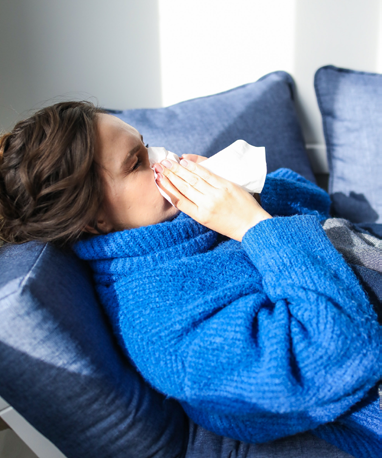
HUMIDIFICATION helps to protect your respiratory system
HUMIDIFICATION helps to protect your respiratory system
Relative humidity between 40% and 60% is ideal • To increase the respiratory epithelium protection, • To maintain mucous fluidity, • To increase bacteria, virus elimination • To reduce cell damages, • To reduce inflammation process, • To reduce infection virulence.
ACUTE RESPIRATORY INFECTIONS (A.R.I.)

Nasal obstruction, sore throat, tonsillitis, pharyngitis, laryngitis, sinusitis, otitis media,
common cold and pneumonia are commonly acute respiratory infections. These
infections usually have a viral origin. Winter season is mainly the infection period,
because it is the dryest season, with a low outdoor humidity ratio (around 1 – 2 g/kg)
and low indoor relative humidity (< 35%) (7).
When indoor humidity ratio is around 7 – 10 g/kg (relative humidity 40%-60%) (1),
the respiratory infection effects decrease
Correct relative humidity protects your respiratory tract
Respiratory epithelium (presents in nose, pharynx and tracheal system) humidifies, and warms inhaled
air. Additionally it cleans the upper respiratory cavities producing mucous, which binds particulates
that are transported to the pharynx by cilia on the epithelial cells. Each epithelial cell contains about
200 cilia (4). This mucociliary clearance is the first defense line of lung. Loss of it is a significant cause of
respiratory infections (8).

ideal to protect the respiratory epithelium

- Maintain right mucous hydration
- Reduces mucous density,
- Increases mucous fluidity,
- Reduces mucous production,
- Increases mucous layer,
- Increases height ciliary layer
- Increases cilia motion,
- Increases mucociliary clearance,
- Increases particulate elimination,
- Reduces any inflammation risk
- Reduces any tissue damage
- Increases tissue defense,
- Increases tissue repair. (5)(6)

- Causes mucous dehydration
- Increases mucous density,
- Reduces mucous fluidity,
- Increases mucous production,
- Reduces mucous layer,
- Reduces height of ciliary layer
- Immobilizes cilia,
- Reduces mucociliary clearance,
- Reduces particulate elimination,
- Increases inflammation risk
- Increases tissue damage
- Reduces tissue defense,
- Reduces tissue repair. (5)(6)
Correct relative humidity protects your lungs
Particulates and microbes that evade the first line of defense, that is, epithelial mucus, reach the
distal lung. From there, they must be cleared rapidly and efficiently by the second line of defense:
phagocytes. Alveolar macrophages are the dominant phagocytic cells in the lungs (8).
Acute inflammation represents the immediate response to an aggressive agent, of short
duration (a few days or weeks), often abrupt in onset and characterized by intense vasculo-exudative
phenomena. Multiple biochemical mediators start inflammation. Among them, interferons (IFNs) activate macrophages and inhibit the replication of viruses.
Indoor humidity ratio around 7 – 10 g/kg (relative humidity 40%-60%), ideal to increase innate protective macrophage defense and to decrease A.R.I. virulence

RIGHT INDOOR AIR HUMIDITY
(OPTIMAL AT 50% R.H. (3))
- Reduces respiratory cell damage
- Decreases infection of airway epithelium
- Increases virus clearance by protective alveolar macrophages
- Increases inducible antiviral innate immunity.
- Increase type I IFN-mediated and IFN-independent
antiviral defense mechanisms. - Increases other innate defense mechanisms.
- Reduces sensitivity to inflammasome activation,
- Reduces Caspase activation,
- Decreases cytokine (interleukins 1β and 18) production. (5)(6)

Deaths and lung lesions are minimized when humidity is held
between 40 and 60% rh. (2,9)
Effect of relative humidity on the infectivity of air-borne influenza A
virus (9)
Sources (1) C. Mike Scofiel, P.E., and Elia Sterling. Dry Climate evaporative cooling with refrigraration backup, ASHRAE Journal 1992 (2) 2016 ASHRAE HVAC Systems and Equipment Handbook 2016, Chap 22. Humidfiers (3) Blausen.com staff. «Medical gallery of Brausen Medical 2014». (4) Scherzad A, Hagen R, Hackenberg S. Current Understanding of Nasal Epithelial Cell Mis-Differentiation. J Inflamm Res. 2019;12:309- 317 https://doi.org/10.2147/JIR.S180853 (5) Kudo E, Song E, Yockey LJ, Rakib T, Wong PW, et al. 2019. Low ambient humidity impairs barrier function and innate resistance against influenza infection. PNAS 116:10905–10 (6) Annu. Rev. Virol. 2020. 7:2.1–2.19 Seasonality of Respiratory Viral Infections Miyu Moriyama,1 Walter J. Hugentobler,2 and Akiko Iwasaki1,3,4 (7) D. Pedro Rodriguez Ramos. La importancia de la humedad relativa en el control ambiental. Calidad del aire interior (8) William J. Janssen, Adrianne L. Stefanski, Bruce S. Bochner, Christopher M. Evans, Control of lung defense by mucins and macrophages: ancient defense mechanisms with modern functions, European Respiratory Journal Oct 2016, 48 (4) 1201-1214; DOI: 10.1183/13993003.00120-2015 9) LESTER W Jr. The influence of relative humidity on the infectivity of air-borne influenza A virus, PR8 strain. J Exp Med. 1948;88(3):361-368. doi:10.1084/jem.88.3.361 Author: P.E. David, Pharmacist and HVAC specialist at Armstrong International



